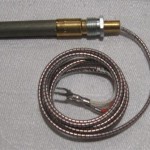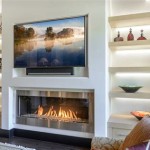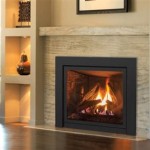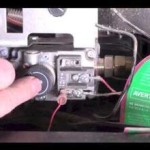Mounting a TV Over a Fireplace with a Stone Surround: Considerations and Best Practices
Mounting a television above a fireplace, particularly one clad in stone, presents a unique set of challenges and opportunities. The aesthetic appeal of this configuration is undeniable, creating a focal point in the room that blends entertainment and architectural design. However, successfully executing this requires careful planning, appropriate tools, and a thorough understanding of the structural and technical limitations involved. This article delves into the key considerations, potential problems, and recommended practices for mounting a television over a fireplace encompassed by stone.
Assessing the Feasibility and Potential Drawbacks
Before embarking on the project, a comprehensive assessment is crucial. This involves evaluating several factors that will directly impact the success and longevity of the installation. The first consideration is the height of the fireplace and the intended viewing angle. Mounting a television too high can lead to neck strain and an uncomfortable viewing experience. Ideally, the center of the screen should be at or slightly below eye level when seated. If the fireplace mantel is already high, alternative locations for the television may need to be explored.
Another significant concern is the heat generated by the fireplace. While modern televisions are designed to withstand a certain degree of ambient heat, prolonged exposure to excessive temperatures can damage internal components, shorten the lifespan of the device, and potentially void the warranty. This is especially true for gas or electric fireplaces that radiate significant heat upward. A thorough inspection of the fireplace and its heat output is vital.
Furthermore, the composition and thickness of the stone veneer or solid stone surrounding the fireplace must be analyzed. Different types of stone possess varying degrees of porosity and structural integrity. Some stones may be easily drilled into and provide a solid anchor point, while others may be brittle and prone to cracking or crumbling. The weight of the television and the mounting bracket must be adequately supported by the stone's structural capacity. Consulting with a professional stonemason can provide valuable insights into the stone's properties and its suitability for supporting a television mount.
Finally, consider the accessibility of electrical outlets and cable management. Typically, outlets are not conveniently located behind the desired television mounting position. Running electrical wiring and cabling behind the stone requires careful planning and may necessitate the services of a qualified electrician to conform to local building codes and safety regulations. Concealing wires is essential for maintaining a clean and aesthetically pleasing appearance.
Selecting the Right Mounting Bracket and Hardware
Choosing the appropriate mounting bracket is paramount for a secure and stable installation. Several types of brackets are available, each offering different features and functionalities. Fixed mounts provide a simple and low-profile solution, holding the television flush against the wall. Tilting mounts allow for adjusting the vertical viewing angle, which can be beneficial if the television is mounted slightly higher than the ideal eye level. Full-motion mounts, also known as articulating mounts, offer the greatest flexibility, allowing the television to be extended, tilted, and swiveled for optimal viewing from multiple locations in the room. The choice of bracket depends on the specific viewing requirements and the desired range of motion.
The weight capacity of the bracket must exceed the weight of the television by a significant margin, typically at least 25%. This ensures that the bracket can safely support the television even under dynamic loads, such as when adjusting the viewing angle. The bracket’s mounting pattern, known as VESA (Video Electronics Standards Association), must also be compatible with the mounting holes on the back of the television. VESA patterns are standardized and measured in millimeters. Verify that the bracket’s VESA pattern matches the television’s specifications to avoid compatibility issues.
Selecting the appropriate hardware for anchoring the bracket to the stone is equally crucial. Standard drywall anchors are not suitable for stone installations. Instead, specialized masonry anchors designed for use in stone, brick, or concrete are required. These anchors typically feature expansion sleeves or threads that grip the surrounding material, providing a secure and robust hold. The size and type of anchor must be selected based on the weight of the television, the type of stone, and the thickness of the stone veneer or solid stone. Concrete screw anchors, sleeve anchors, or wedge anchors are commonly used for television mounts on stone surfaces. Always consult the manufacturer's specifications for the recommended drill bit size and installation torque.
When working with stone, the type of drill bit is as crucial as the anchors. Standard drill bits are not effective on stone. Carbide-tipped drill bits designed for masonry and stone are required. These bits feature hardened tungsten carbide tips that can withstand the abrasive nature of stone. The drill bit should be sized appropriately for the chosen masonry anchors. A hammer drill is also essential. This drill utilizes a hammering action in conjunction with rotation to effectively penetrate the stone. Apply consistent and moderate pressure when drilling, avoiding excessive force that could crack or damage the stone. Keep the drill bit cool by periodically removing it from the hole and clearing away debris.
Installation Techniques and Safety Precautions
Before commencing the installation, disconnect the power to the circuit to prevent electrical shock. Clearly mark the desired location for the television mount on the stone surface. Use a level to ensure that the bracket is perfectly aligned and that the television will be mounted horizontally. Double-check the measurements before drilling any holes.
When drilling into stone, take precautions to minimize dust and debris. Wear safety glasses and a dust mask to protect your eyes and respiratory system. Cover surrounding surfaces with drop cloths or plastic sheeting to prevent dust contamination. Consider using a vacuum cleaner with a brush attachment to collect dust as you drill. Start with a small pilot hole and gradually increase the size of the hole to the required diameter for the masonry anchors. This helps to prevent the drill bit from wandering and ensures a clean and accurate hole.
Insert the masonry anchors into the drilled holes and tighten them according to the manufacturer's instructions. Avoid over-tightening the anchors, which could damage the stone or strip the threads. Once the bracket is securely anchored to the stone, carefully mount the television onto the bracket. Ensure that the television is properly aligned and that all screws are tightened securely. Double-check the stability of the installation before releasing the television.
Cable management is an essential aspect of a professional installation. Concealing wires and cables is crucial for maintaining a clean and organized appearance. Consider running the wires through a wall cavity behind the stone or using cable management channels to hide them along the wall. Avoid running wires directly over the fireplace, as the heat can damage the insulation and pose a safety hazard. If running wires behind the stone is not feasible, paintable cable raceways can be used to conceal the wires along the surface of the stone. Secure the wires with cable ties or clips to prevent them from dangling or becoming tangled. The use of a surge protector is highly recommended to protect the television from power surges.
After the installation is complete, test the functionality of the television and all connected devices. Verify that the picture and sound are working correctly and that all cables are properly connected. Ensure that the television is securely mounted and that there is no wobble or movement. Periodically inspect the installation to ensure that the anchors are still secure and that the bracket is in good condition. If any signs of looseness or damage are observed, tighten the anchors or replace the bracket as needed. The long term monitoring of the stone and television mount is essential to ensure safety and structural integrity.
Remember that working with stone and electrical wiring can be hazardous if not performed correctly. If you are not comfortable with any aspect of the installation, it is best to hire a qualified professional to ensure a safe and successful outcome. A professional installer will have the necessary tools, experience, and expertise to properly assess the situation, select the appropriate hardware, and execute the installation according to industry standards and safety regulations. Ignoring safety precautions can lead to personal injury or damage to the property.
Addressing Heat Concerns and Mitigation Strategies
As previously mentioned, heat is a significant consideration when mounting a television above a fireplace. Prolonged exposure to excessive heat can damage the television's internal components and shorten its lifespan. Several strategies can be employed to mitigate the impact of heat on the television.
The first and most effective strategy is to minimize the heat output of the fireplace. If possible, adjust the fireplace settings to reduce the flame intensity or use a fireplace insert that directs heat away from the television. For gas fireplaces, consider installing a heat deflector or shield above the fireplace to redirect heat away from the television. For wood-burning fireplaces, ensure that the damper is properly closed when the fireplace is not in use to prevent heat from escaping into the room. Regular maintenance of the fireplace, including cleaning the chimney and inspecting the flue, can also help to improve its efficiency and reduce heat output.
Another strategy is to create an air gap between the fireplace and the television. This can be achieved by using a larger television mount or by installing a heat shield behind the television. The air gap allows for better air circulation and helps to dissipate heat away from the television. A heat shield made of reflective aluminum or other heat-resistant material can further protect the television from radiant heat. The effectiveness of a heat shield depends on its size, material, and placement. Experiment with different configurations to find the optimal solution.
Furthermore, consider using a temperature sensor or thermometer to monitor the temperature around the television. This allows you to track the heat levels and take corrective action if necessary. If the temperature exceeds the television's recommended operating range, reduce the heat output of the fireplace or take other measures to cool down the area. Some thermostats can be programmed to automatically adjust the fireplace settings based on the temperature readings.
If the heat is a significant concern, consider alternative locations for the television. Mounting the television to the side of the fireplace or on a separate wall may be a better option. This eliminates the risk of heat damage and provides a more comfortable viewing experience. Evaluate the layout of the room and consider the various options before making a final decision. A professional installer can provide valuable advice and guidance on the best placement for the television.

Smarthome And Theater Systems Residential Solutions Photo Album Tv Mount Over Stone Fireplace In New Canaan Ct

Can I Mount My Tv Above The Fireplace

Mounting A Tv Above Fireplace With Full Tutorial Fixthisbuildthat

Tv Above Fireplace Design Ideas

Made How To Mount A Flat Screen Tv On Stone Fireplace Diy

Natural Stone Fireplaces With Wall Mount Television Design Ideas

Mounting Your Tv Above Fireplace

Stacked Stone Fireplace With Tv Mount Fireplaces

Natural Stone Fireplaces With Wall Mount Television Design Ideas

Double Sided Fireplace With Tv Above Stone Designs Design
Related Posts








